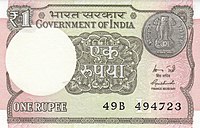| (India) | |
|---|---|
| Value | ₹1 |
| Width | 97 mm |
| Height | 63 mm mm |
| Weight | 90 GSM g |
| Security features | Watermark |
| Material used | 100% (Cotton) Rag Content |
| Years of printing | 1917–1926 1940–1995 2015– |
| Obverse | |
 | |
| Design | One-rupee coin |
| Reverse | |
 | |
| Design | Sagar Samrat oil rig |
The Indian 1-rupee note (₹1) is made up of hundred 100 paise as ₹1 = 100 paise. Currently, it is the smallest Indian banknote in circulation and the only one being issued by the Government of India, as all other banknotes in circulation are issued by the Reserve Bank of India. As a result, the one rupee note is the only note bearing the signature of the Finance Secretary and not the Governor of the RBI.[1] Predominantly pinkish green paper is used during printing.
The 1-rupee note was first introduced on 30 November 1917, but printing was discontinued in 1926.[2] Printing then restarted in 1940 and continued until 1994, when it was stopped again due to cost-cutting measures. Printing resumed for a second time in 2015. The newly-printed notes were first released on 5 March 2015 at Srinathji Temple, Rajasthan by Rajiv Mehrishi, Finance Secretary. Once again RBI decided to issue these notes as per publication in The Gazette of India on 7 February 2020.[3]
- ^ "Issue of Re. 1 denomination currency notes with Rupee symbol (₹) and the inset letter 'L'". RBI. Retrieved 6 January 2018.
- ^ "History of Indian currency: How the rupee changed". The Economic Times. 28 November 2016. Retrieved 22 May 2023.
- ^ "Issue of ₹ 1 denomination currency notes with Rupee symbol (₹) and the inset letter 'L'". Reserve Bank of India.